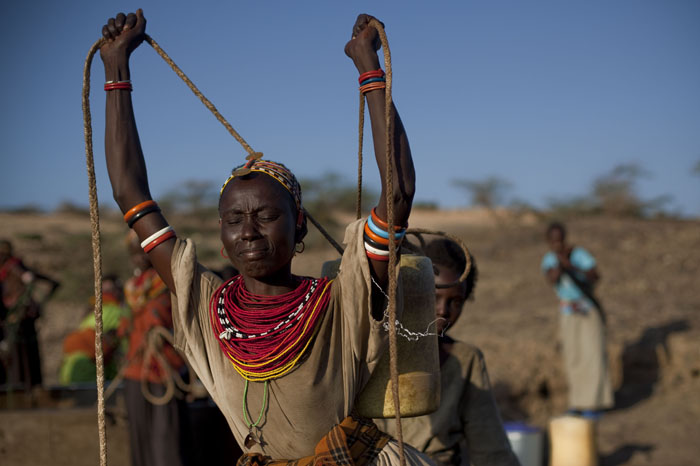
KENYA (BP)–Chin jutted out and eyes slightly closed, Nduri Isandap bobs to the low, resonating music. The shrill a cappella chorus quickly gains momentum and volume. Layer upon layer of beaded necklaces clank in perfect rhythm with each bouncing dance step the women take.
In the center of the tight circle, Isandap feels the excitement of the music. She lets out a “yelp” and jumps straight up, stiff as a board yet beautiful and regal. A smile slowly spreads across her weathered face, though her eyes remain sad. It’s been a long time since Isandap had anything to smile about, let alone celebrate.
It’s been a rough year. When her husband died, she and six children were left to fend for themselves during one of the worst droughts in Kenya’s history. Without adequate water, most of their livestock died and food is scarce. There hasn’t been much cause for celebration — until today.
Today, water came to her desert village. Today, thanks to a Southern Baptist water project, everyone will bathe and have enough to drink. Today, Isandap didn’t walk seven miles to the hand-dug well or worry about how to make 20 litres (5.2 gallons) of water stretch for household chores, seven people and a few goats.
“We are dancing because we very much appreciate what has been done for our village,” Isandap says, pointing to the four donated water tanks not more than 100 yards away.
The project brought water closer for 4,000 people. While that’s just a small drop in the ocean when compared to the World Health Organization’s estimates of 1 billion people without access to safe water, the difference it makes in Isandap’s village is significant. The closest hand-dug well is about a two-mile walk. When it dries up — which happens every dry season — Isandap treks seven miles to a deeper well.
With clean water access increasingly scarce, the burden of securing a daily water supply has become a daunting task for women and young children in rural sub-Saharan Africa — threatening an ancient way of life.
WHEN WATER IS SCARCE
Isandap and her pastoralist clan live in gumdrop-shaped thatch huts scattered across the sandy plateau, herding animals to survive. Even in a good year, life here is extremely precarious. Average daytime temperatures hover around 100 degrees.
In an effort to beat the heat, Isandap bends through the small opening of her hut just as the sun peaks out from the horizon. She grabs her scratched-up 20-litre yellow jug and leans back into the smoky hut, giving last-minute instructions to her groggy teenage daughter. Then she’s off to the well.
The footpath rises and falls with the gentle sandy slopes, weaving around pesky thorn bushes. Sun-bleached remains of once-mighty herds of goats, sheep and camels that died of thirst are scattered as far as the eye can see. The piles of bones are a constant reminder of how important water is. A person can survive without food for 30 days. Without water, survival is possible for only five to seven days.
The arid lands of northern Kenya have been the hardest hit by the drought. In some villages, it has not rained in years. Isandap’s village is one of the lucky ones. Even if it’s only a sprinkle here and there, rain dramatically changes the area. Tufts of green adorn the trees and bushes, brightening the normally dull brown landscape. But, this day, more importantly, the closest well — a 17-minute walk — has water. Just a week ago, the well was bone dry.
“Even last week I walked to the other well. I left at 7 a.m. and returned home at 7 p.m.,” Isandap says. “The lines were long because it was the only well with water. Some women spent the night there so they could keep their place in line.”
At the well, the widow joined some friends already in line and catches the latest news. A rock python, measuring nearly three feet in diameter, strangled two boys last night. They were watching the family goats at the livestock camp in the hills. The women quickly switch the topic in an effort not to worry about their own sons at the camp trying to find water for the remaining herd.
They manually lower makeshift buckets down the 30-foot well and back up again using homemade ropes. Isandap is eerily skinny from the tough year, yet her arm muscles ripple as she repeats the process twice more, filling the container with muddy, arsenic-laced water. She straps the 44-pound jug onto her back and starts the arduous trek home.
Isandap and her daughter will make this trip three more times today.
In sub-Saharan Africa, UNICEF (United Nations International Children’s Emergency Fund) estimates 40 billion hours of labor are wasted each year carrying water over long distances. The tragedy is that the water they work so hard to collect is often dirty and polluted.
Women trapped in this situation have little time for other activities, such as childcare, rest or productive work. So when water gushes out of the nearby water tanks provided by Southern Baptists, word spreads quickly among the women.
THE COST OF CLEAN WATER
Now, an almost giddy atmosphere surrounds the water tanks at Isandap’s village. Women smile, laugh and tease. Mothers give their toddlers a good washing. Boys plop down in the mud, building dams and mud pies. Girls playfully splash each other.
The tanks and series of pipes connecting to the borehole miles away cost around $20,000, provided by the Southern Baptist World Hunger Fund. It takes about $6 worth of diesel — an expense the community intends to cover — to run the borehole long enough to fill all four tanks, which hold enough water for two days.
Village elder Andrew Amalo insists that raising their own money is, in fact, local custom and exactly how they want it, even though World Health Organization estimates that two-thirds of those without access to safe water live on less than $2 a day.
“That is how it is done here,” Amalo nevertheless says. “When a boy goes off to school, the entire village collects money to support him. Whether it is 5 shillings (6 cents) there or 20 shillings (26 cents) here, we pull our resources together. Everyone shares. It is our way.”
This type of partnership between Southern Baptists and Isandap’s village allows the community to have ownership over the project. They decide when water is needed most.
No one knows when the tanks will be filled again, so everyone tries to get as much as they can. In less than an hour, Isandap and her children gather enough water for two days.
–30–
Sue Sprenkle is a writer for the International Mission Board’s global communications team. To make a donation to the Southern Baptist World Hunger Fund, visit https://worldhungerfund.com.











